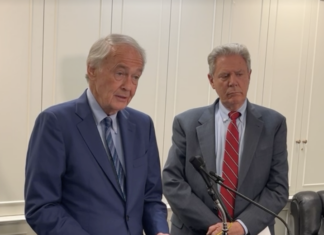Germany and the Genocide: Witness, Accomplice or Perpetrator?
By Muriel Mirak-Weissbach
Special to the Mirror-Spectator
BERLIN – While in Turkey institutions a good hundred years after the fact are still inventing ways to deny that their predecessors in the Ottoman Empire perpetrated a genocide against the Armenians, in Germany efforts are afoot to explore its role, as Turkey’s wartime ally, in the extermination campaign. Among the numerous events organized throughout the country to commemorate the centenary was an international conference in Berlin on March 1-3, focusing on the role of the German empire. Cosponsored by the Lepsiushaus in Potsdam and the German Historical Museum in Berlin, the three-day gathering brought historians and academics together to examine various facets of the relationship between Imperial Germany and the Young Turk regime. Although last year the German History Museum included the Armenian Genocide in a centennial exhibition on the outbreak of World War I, and the Lepsiushaus hosted a conference on its namesake, Johannes Lepsius, as “a German exception” in 2012, this was the first time that the issue of Germany’s role has been featured in the country.
Such an event would have been unthinkable 15 years ago. As Ronald G. Suny of the University of Michigan, Ann Arbor, noted, in the interim period serious researchers no longer deal with the question, whether or not a genocide occurred, but rather how. A key factor in this matter in Germany has been the circulation of the documents relating to the Armenian question contained in the wartime archives of the German Foreign Ministry. Martin Kröger, from the Political Archive in Berlin, presented the history of this most important state source, which includes hierarchically ordered reports organized in folders by country name and numbers. The relevant documents here are registered under “Turkey 183” and contain 20 thick volumes relative to the years 1915-1920. Although the complete documents on the Armenian question have not been published – which represents a “gap” as Kröger put it – there does exist what Lepsius himself issued, and the edition by Wolfgang Gust, which corrects and completes the former, and includes source references.
Gust’s massive work was published in book form in German in 2005, and since then has become available online on his website www.armenocide.net. The book has also appeared in English.
With such valuable source material readily accessible, scholars have been thrashing out the crucial questions as to what the Germans knew about the deportations and mass killings, and how they responded.
Genocide: Why and How?
Before addressing the German role per se, speakers at the conference offered some new approaches to understanding the nature of the Young Turks’ crimes against humanity. Faced with the absence of concrete material evidence, in the form, say, of minutes of a meeting of the top CUP leaders, which might have detailed their deliberations on a “final solution to the Armenian problem,” Erik Jan Zürcher of Leiden University has developed a novel methodological approach. He proposes examining other major decisions taken by the Young Turks – decisions which are documented – with the aim of deducing patterns in the decision-making process, and using these to suggest how the decision for genocide came about. Reviewing first what is known about the process between October 1914 and May 1915 leading to the deportations, as well as the evidence showing how they were used to commit mass murder, Zürcher moved to consideration of four other major decisions: the January 1913 coup d’état, the expulsion of the Greek Orthodox (Rum) in June 1914, the treaty with Germany in August 1914 and the determination to attack the Russian fleet in October 1914. In a careful analysis of each case (too detailed to be replicated here), Zürcher sketched out what he calls the “Unionist decision making culture.” Its salient features include the use of informal institutions initially and the lack of formal policy statements. Decisions were taken by a very small number of CUP leaders and in a state of utmost secrecy; facts on the ground were established to destabilize possible opposition. Among the several alternatives available in each case, they always opted for the most radical, which also entailed significant risks, a sort of gamble. On this basis, he hypothesizes that the gravest decision taken, to commit genocide, came into being in a similar fashion.
Taner Akçam of Clark University also looked at the Genocide in a new light. Rather than focusing exclusively on the 1915-1918 period, in his “project proposal” he reviewed developments from 1878 to 1923 as a “genocidal process” which reached its climax in 1915. Among the factors leading to the periodic massacres, Akçam stressed that the reforms, especially when forced through by actions taken by the Great Powers, led to the violent reaction on the part of the Ottoman Empire. In conclusion, he depicted the Genocide as part of the process of the collapse of four empires, the German, Austro-Hungarian, British and Ottoman.
Mark Levene of the University of Southampton, too, located the issue within the context of the Great Powers in a speech on “Deadly Geopolitics, Ethnic Mobilizations and the Vulnerability of Peoples, 1914-1918.” In this presentation (which may not have been the best choice for the keynote), Levene tended to place the Armenian issue in relative terms; though not questioning that what happened was “extreme and exceptional,” he added that it was “not necessarily uniquely genocidal in the context of the Great War.” By focusing on the way the Great Powers supported small states and ethnic groups, seeking to mobilize them as allies against their wartime enemies, Levene placed the Armenians in a position comparable to other groups, like the Czechs, the Poles, the Zionists etc. and wondered whether Armenian nationalists had really grasped the all-or-nothing nature of the conflict, or perhaps miscalculated. In subsequent Q&A sessions, not a few participants objected to this analysis, as it ignores the specificity of the Armenian case and, albeit implicitly, portrays the Armenians as responsible for provoking the mass murders – a thesis cherished by denialists.
Focus on Germany
There can be no doubts about Germany’s awareness of what the Young Turk government planned and then executed. The title of the conference spelled this out: “Witness to a Crime of the Century – The German Empire and the Armenian Genocide.” The archives are full of documents from German Ambassador Hans von Wangenheim reporting on the Young Turks’ plans to deport the Armenians. Among them is an entry, cited by several speakers, in which Wangenheim issues orders to his consuls to the effect that they should try to “soften” the form of the deportations but not “prevent” them. But was Germany merely a witness? As a military ally in the war, its officers were on the scene. What role did they play?
To locate the problem historically, one has to review German policy prior to the war. As Christin Pschischholz from the Potsdam University and Lepsiushaus presented it, Imperial Germany had plans for the future which affected the Armenians. Kaiser Wilhelm II, who had considerable German economic interests in the Ottoman Empire, was intent on keeping its territory intact and maintain stability of the Sultan. This, she suggested, would explain why there was no outcry against the Hamidian massacres in the 1890s. Germany’s imperial interests in the Ottoman Empire, which it viewed as a counterpart to Britain’s India, meant that if the empire were to crumble, then, as Ambassador Wangenheim put it in 1913, Germany must secure the western Anatolian highlands for itself.
As for military policy prior to the war, Alexander Krethlow from Bern University showed how the attitude of one leading military officer evolved over time. Field Marshall Colmar von der Goltz, who was not anti-Armenian in the 1880s when he first went to the region, at the end of the decade had undergone a change. He considered the possibility that Russia might march into the Armenian populated areas and thus push the Armenians towards rebellion. This was of course to become a standard rationalization used by the Young Turks to justify their repression, and it was Goltz who circulated the view in the general staff that the Armenians could be a potential danger in the event of war with Russia.
The role of the German military in the crucial war years 1915-1916 is the subject of controversy. Ashot Hayruni from the Yerevan State University addressed the question of whether or not Imperial Germany could have prevented the genocide without sacrificing its wartime alliance, and concluded that it could have. To be sure, State Secretary Gottlieb von Jagow had said in September 1916 that Germany could not go so far as to break the alliance, and American Ambassador Henry Morgenthau, after meeting with Wangenheim, had reported to Washington his view that he, Wangenheim, was the only man, and Germany, the only government, which could stop the extermination policy. But, Morgenthau added, their only aim was to win the war. Nonetheless, in the view of Hayruni (which may have been naïve, or wishful thinking), Germany could have had it both ways. Citing moves by General Liman von Sanders, who forbade the deportation of Armenians from Smyrna in November 1916, and Goltz, who did the same in Mosul, Hayruni argued that Germany could have, but did not.
In Krethlow’s reading, Goltz was indeed a powerful figure, but one who was clearly opposed to the Armenians. When he arrived in Constantinople in late 1914, he was already the highest ranking German officer there and, following the failure of the Caucasus offensive, rose to become advisor to Enver Pasha, and to the headquarters. Thanks to his knowledge of Turkish, Krethlow noted, he was very well informed, and when Enver presented his plans for “resettlements” in March 1915, Goltz approved them. In October, Goltz even wrote letters home describing the “unending suffering” of thousands of Armenians he personally saw on his way to Baghdad; he wrote that he felt “compassion” but that he could not help. Krethlow’s conclusion is that Goltz stood idly by. Not only: although informed of atrocities by other officers, his strategy was to hush up and cover up.
The Goltz case leads to another question, addressed by Ozan Arslan, from the University of Economics in Izmir: “Who is in Charge of the Caucasian Front? An Assessment of the Decision-Making Process and the Uneasy Alliance between the Imperial German and Ottoman Army Officers, 1914-1918.” Although many German staff and commanding officers were posted to this front, Aslan reported, Germany’s main strategy was to close the Straits, block Russian trade routes and open fronts against the British and the Russians. In other words, the Caucasian front was not their priority. Countering this reading, Raymond Kevorkian noted in his concluding commentary that the Ottoman Third Army was in the Caucasus, and that the priority of the Young Turks there was to remove the Armenian population. Thus, the absence of the Germans there was “not an accident.”
Some military officers were complicit, and actively so; among them was Count Wolffkeel von Reichenberg, under whose command the Urfa rebellion was suppressed, as Judith Perisic from the University of Mainz reported. But even deeper levels of complicity and depravity have been documented, among them, the case of a German embassy bureaucrat. This was Hans Humann, whose comment on the fact that the Armenians were to be eliminated, was that it was “tough, but useful.” Humann, as Jürgen Gottschlich from Istanbul and Berlin portrayed him, was a close friend of Enver and a true Turcophile. He expressed his adulation for Enver in a letter, calling him a “Turkish Napoleon,” ready to deploy all means necessary to defend his homeland, a man free of moral scruples, someone who could act, and would. Humann was influential and active, playing a role in key matters like the deployment of German ships to Constantinople, the justification of the deportations because of the alleged “Armenian danger” and the alienation of Wangenheim’s successor, Paul Wolff-Metternich, who was pro-Armenian. Humann’s profound immorality found expression in his justification of the mass murders (following the assassination of Talaat) and in his support for Hitler in 1933.
Humanitarian networks and moral politics
In contrast to such evil, there was also much good that was the work of Germans on the scene. Not only the cited Ambassador Metternich, but also Consul Walter Rössler, Vali Djelal Bey and Beatrice Rohner, whom Sigurd Sverre Stangeland from the Collegium Hungaricum et Germanicum in Rome, presented as “A Triumvirate on the Side of the Armenians.” All three lent active support to Armenians, whether orphans in the Aleppo orphanage, or those in camps, Rohner channeling money secretly to those in need, in an operation made possible by Vali Djemal Bey. Aleppo, where Rössler was Consul, was the center for humanitarian aid, and funds raised by church organizations in America, Switzerland and Germany arrived there. The Catholic Archbishop in Cologne had sent a letter to all German churches asking them to collect money, but secretly, because the government opposed it, and they raised a million marks. Further humanitarian missions included the Red Cross and the Near East Relief based in the US, as detailed by Alexandra Przyrembel, from Essen. New information contained in papers from the estate of Rössler, particularly correspondence with the Kaiserwerther Deaconesses school, which Fabian Stremmel, from Ehringhausen has consulted, sheds new light on their role in organizing aid for Armenians.
In the concluding panel, Dr. Rolf Hosfeld, scientific director of the Lepsiushaus, depicted the process “From the Moral Politics of the Late 19th Century to the Beginnings of International Justice.” This spanned the time from Gladstone’s 1895 speech on the Armenian massacres to the official legal definition of “genocide” crafted in 1944 by Rafael Lemkin. For Gladstone, civil society campaigns should accomplish what governments at the time did not. Thus, pro-Armenian movements in England, Italy, France and Switzerland emerged and began to “speak a new language of human rights.” In Germany the central figure was Johannes Lepsius, whose 1896 book, Armenia and Europe, had an international impact. Lepsius was, Hosfeld said, like Gladstone, a “liberal imperialist with ethical principles.” As a result, the moral policy of the pro-Armenian movement around Lepsius clashed with official imperial policy and they came under harsh attack. Following his trip to Constantinople in 1915, as head of the newly established German-Armenian Society, he opted not to remain silent, but openly challenged the government for its subservience to the Ottoman leadership. The next year he published his major work on the Armenians, which documented the state-run extermination campaign, and in 1918 openly spoke of Germany’s “complicity” through “toleration and cowardly inaction.”
A chapter of German history?
If, as the conference made clear, Imperial Germany was complicit in the Genocide – to varying degrees and forms – should it not also recognize it as such? This question took center stage during a round table discussion open to the broad public at the end of the proceedings. Here, Shermin Langhoff, the Intendant of the Maxim Gorki theatre, joined political figure Markus Meckel and Genocide researcher Mihran Dabag of Bochum. The reference point for the discussion was a resolution passed by the German parliament (Bundestag) in 2005, entitled, “Remembering and Commemorating the Expulsions and Massacres of the Armenians 1915 – Germany must contribute to Turkish-Armenian reconciliation.” Without using the G-word, the resolution said the government regretted the role played by the German Empire, which, though informed of the expulsions and killings, had done nothing to stop them. It also spoke of “the duty of Germany to recognize its responsibility.” Meckel, who was the last foreign minister of East Germany and a co-author of the 2005 resolution, called it a “scandal” that the G-word could not be used, adding that denial was equivalent to repeating the genocide.
It is expected that a new debate will take place in the Bundestag on or around April 24 this year. Will something new emerge? That remains to be seen. What is certain is that there is no longer any taboo regarding discussion of the German role, and, in the context of a massive array of commemorative events planned for the year, including a month-long series at the Gorki theatre, pressure will build for the government to act.
Germany and the Genocide: Witness, Accomplice or Perpetrator?
Top 5 Articles
- Trending
- Most Viewed
- Most Commented
- Holy Trinity Armenian Apostolic Church ‘Honoring Our Nonagenarian Members’
- Houshamadyan: Cuisine and Fried Omelets from Diyarbekir
- Haik Kazazyan Wins 2025 Classic Violin Olympus International Competition
- UC Berkeley Human Rights Center Cancels Film Screening on Genocide Remembrance Day
- China Gains Momentum, Just Not in Armenia
- Why I Am Grateful to Erdogan, the Dictator of Turkey
- A Political Whirlwind Engulfs Nagorno Karabakh
- Libya’s Interim Government Recognizes the Armenian Genocide Once Again
- Robert Bedrosian Marries High Tech With Ancient Armenian Manuscripts
- Aleppo Aid through St. Kevork Armenian Apostolic Church of Houston







